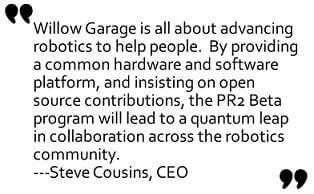Breaking News: Willow Garage Announces 11 Winners for its Robot Give Away

Share
Today is a good day to be a robotics engineer. Not only is it the first day of ICRA, it's the day that Willow Garage (WG) officially announced which research groups will be part of their PR2 Beta Program and receive one of their very own PR2 robots to work with. I had a chance to talk with Willow Garage and get some insight into the project. While they originally conceived of parting with just ten of their unique open source PR2 platforms, Willow Garage had such an amazing pool of formal proposals (78 in total) that they had to crank it up to eleven. That's about $4.4 million worth of robotic equipment that WG is providing for its winners without cost. For the next 24 months, or so, these institutions will use the PR2 to develop ground breaking software and, because all of it will be shared via open source licenses, that code will be available to robots everywhere via ROS. Millions of dollars invested, but untold riches in new open source robotic software ready to be discovered. Read on to learn about some of the amazing projects that the P2 Beta Program will enable.
I am an unashamed fan of Willow Garage's work, not just for their humorous Warhol-esque posters, but for their dedication to making the future of robotics an open source one. Robotics is a detail driven, and technically challenging industry. Individual labs are often required to build their hardware and software from the ground up before they can even approach the visionary ideas that inspired them to start their work. Too much time is lost "re-inventing the wheel". Open source can change all that. By sharing innovations institutions give each other the tested ingredients they need to build their programs quickly. Willow Garage's PR2 Beta Program takes it even further. Not only are they fomenting the development of open source code, they are actively giving researchers world-class hardware to test and refine that code. This isn't just keeping everyone from having to re-invent the wheel, it's handing them a car. Who knows where they'll go with it.
Here's the official list of PR2 Beta recipients:
- Albert-Ludwigs-Universität Freiburg with the proposal TidyUpRobot
- Bosch with the proposal Developing the Personal Robotics Market: Enabling New Applications Through Novel Sensors and Shared Autonomy
- Georgia Institute of Technology with the proposal Assistive Mobile Manipulation for Older Adults at Home
- Katholieke Universiteit Leuven with the proposal Unified Framework for Task Specification, Control and Coordination for Mobile Manipulation
- MIT CSAIL with the proposal Mobile Manipulation in Human-Centered Environments
- Stanford University with the proposal STAIR on PR2
- Technische Universität München with the proposal CRAM: Cognitive Robot Abstract Machine
- University of California, Berkeley with the proposal PR2 Beta Program: A Platform for Personal Robotics
- University of Pennsylvania, GRASP Laboratory with the proposal PR2GRASP: From Perception and Reasoning to Grasping
- University of Southern California with the proposal Persistent and Persuasive Personal Robots (P^3R): Towards Networked, Mobile, Assistive Robotics
- University of Tokyo, Jouhou System Kougaku (JSK) Robotics Laboratory with the proposal Autonomous Motion Planning for Daily Tasks in Human Environments using Collaborating Robots
You'll notice that four of these eleven groups are international. That's more than Willow Garage originally anticipated, but it demonstrates the scope of the talent that sent in proposals for the PR2 Beta Program. If anything, that range of applicants already made WG's difficult task of selecting recipients that much more challenging. Narrowing the list down from 78 proposals wasn't easy.
The criteria for selection reflects Willow Garage's own philosophy. A strong preference was given to those institutions which have shown a commitment to open source robotics. After all, WG is one of the driving forces behind the robot operating system (ROS), which will serve as the means of disseminating all the new code that the PR2 Beta Program will generate. WG also had a preference for groups and proposals that would potentially give a large number of students access to the PR2 robot. Looking at the press release from Willow Garage, you'll see that many of these proposals (MIT, USC, etc) involve several labs/groups at the same institution. One of the points of the PR2 robot is for it to allow researchers to quickly test and perfect their ideas. That makes it ideal for large groups with many different developers looking for quality time with the robot.
Willow Garage has a strong commitment to develop robots that can assist and work with humans. Many of the projects they selected involve getting the PR2 to not only perform valuable tasks, but to do so in a human environment. Even those projects which do not expressly propose to interact in the people-sphere are aimed towards creating robust and practical applications that will serve humans well. There's no doubt that Willow Garage is still the company looking to build a personal robot.
Be Part of the Future
Sign up to receive top stories about groundbreaking technologies and visionary thinkers from SingularityHub.


While there are some big name institutions in this list (MIT, JSK, Stanford, etc), there are also some labs still making names for themselves. Peter Abbeel, fresh from getting the PR2 to fold his towels, is a young professor and part of the group that wrote the proposal from UC Berkeley. In fact, looking at the list as a whole, you can tell Willow Garage was also selecting for a diversity of strengths. There's a good selection of experience, enthusiasm, and areas of expertise.
I would have liked to see at least one complete unknown on this list. A random hacker space or amateur robotics engineer (maybe a Lego Mindstorms guru?) would have added some interesting flavor to the mix. Willow Garage did say that they received some great letters of intent (the first round of applications) from groups that were off the radar, but that few, if any, had the resources available to create the formal proposal. That's just an artifact of our times, I think. Hopefully the years ahead will reveal more low-budget yet dedicated developers finding the means to take advantage of programs like this one.
It's hard to pick a favorite among these eleven, and hopefully they'll all produce some amazing work in the next two years. I was told that Bosch has been showing some really amazing commitment to the project for such a big corporate name. Not only did they convert to ROS about a year ago (gasp! an open source international company?), they're also sharing hardware with the rest of their PR2 Beta group. Advanced sensors, including "robotic skin" will be distributed to some of the other labs. (That skin may be similar to the product and program we saw coming from Peratech). UPenn is also working on some hardware adjustments, looking to develop a system by which the PR2 could change its claw to various auxiliary appendages carried in a toolkit on the robot. I'm personally excited to see how UC Berkeley will build on previous work with towel folding - their proposal calls for the PR2 robot to do a full load of laundry, assemble furniture from IKEA, and to learn a task by watching (as we've seen with other robot platforms).
It's important to keep in mind that none of these teams will be working in a vacuum. The code produced will be shared with the greater open source community, just as these researchers form tighter collaborations amongst themselves. Willow Garage will soon be hosting a conference so that the students and group leaders can meet before the program launches. During the next two years, there will be regular check ins, exchanges of information, and fun interactions between labs, robots, and students. The professional relationships built here may pay dividends far beyond the PR2 Beta Program. In a way, this project isn't simply building the next round of software for robots, it's helping to create the next generation of robotics engineers with first hand experience of the advantages of open source.
Willow Garage seems hesitant to speculate on how the PR2 Beta Program will develop beyond this first round. ROS and other open source systems develop at their own pace and in their own unpredictable directions. Still, one hopes that these first two years will see such amazing successes that Willow Garage will have no choice but to renew and expand the program. It's many years (or decades) down the line, but I would love to see an open source robot in every high school around the globe.
Of course, for those of us looking to the future, it's not enough to simply anticipate the next round of technological innovations, we must also try to understand the mechanics that shape those innovations. Open source robotics , as enacted by Willow Garage and many others around the world, is a time saving and effort-maximizing paradigm. Researchers sharing their work openly will build more quickly, and with more robust results. This is a clear path towards an acceleration in robot technology. Not only could that path provide us with amazing robots far sooner than many anticipate, it will do so in a way that fosters cooperation on a large scale. That's important if we want to build a better world, and not one simply filled with robots. So good luck to all the recipients of the PR2 Betas - your proposals all sound great, and I can't wait to see them come to fruition. Though, as those at Willow Garage have said, what will be more amazing is what we don't anticipate.
[image credits: Willow Garage, Jorge Cham via Willow Garage]
[source: Willow Garage (Press Release and interviews)]
Related Articles

These Robots Are the Size of Single Cells and Cost Just a Penny Apiece

In Wild Experiment, Surgeon Uses Robot to Remove Blood Clot in Brain 4,000 Miles Away

A Squishy New Robotic ‘Eye’ Automatically Focuses Like Our Own
What we’re reading




